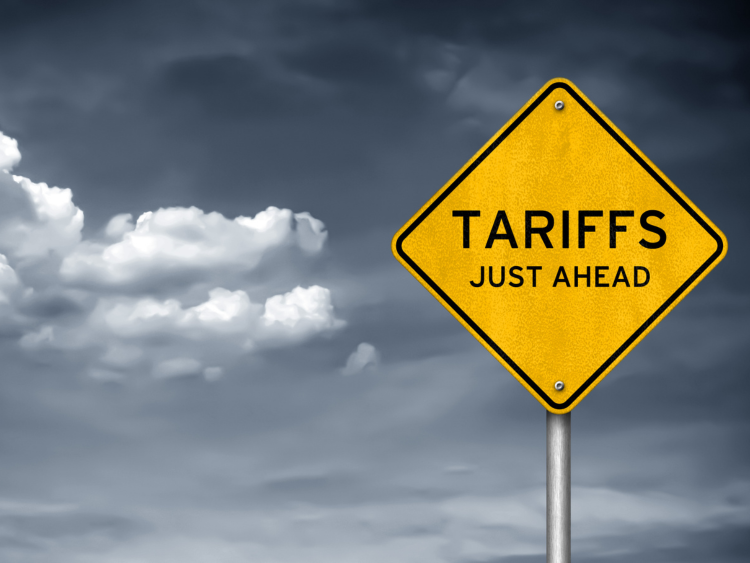Final Thoughts

February 11, 2025
Tariff handicapping: Win, lose or draw?
Written by Greg Wittbecker
The latest turn on U.S. tariff policy has seen a universal, 25% tariff applied to all countries effective March 12, 2025. It applies to primary aluminum and its ‘derivatives’. We interpret that to apply to semi-fabricated and finished products under Harmonized Tariff Schedule (HTS) Chapter 76. We also suspect that it will be extended to other aluminum HTS codes, such as 8708, which covers aluminum wheels.
The Trump Administration had talked about universal tariffs for some time; however, the timing and scope of the tariffs were unexpected for several reasons. It gets us into a discussion of who is winning, losing, and standing pat.
Winners- Domestic producers, but with an “Ask”
The imposition of a 25% tariff on all imports Is favorable to domestic, primary producers such as Alcoa and Century. They stand to benefit from the appreciation in the Midwest P1020 premium without incurring any direct cost. This windfall does come with some “asks” from the government. One of the drivers behind the latest tariffs was the Administration’s desire to see domestic primary aluminum achieve 80% capacity utilization. Here’s the current operating rates of the industry:
| (in 000 metric tons) | U.S. Capacity | U.S. Operating Rate | Idled Capacity | 2024 % Operating Rate |
| ALCOA | ||||
| Massena, NY | 130 | 130 | 0 | 100 |
| Warrick, IN | 215 | 161 | 54 | 74.9 |
| CENTURY | ||||
| Hawesville, KY | 250 | 0 | 250 | 0 |
| Mt. Holly | 230 | 172.5 | 57.5 | 75 |
| Sebree, KY | 220 | 220 | 100 | |
| MAGNITUDE SEVEN | ||||
| New Madrid, MO | 240 | 0 | 240 | 0 |
| TOTAL U.S. | 1,285 | 683.5 | 601.5 | 53.2 1/ |
1/ The Executive Order states that the current operating rate is 52%, however our numbers are based on Alcoa, Century publicly available production and capacity information from their latest Earnings Presentations
To achieve 80% operating rates, we need to run 1,028,000. That would require 344,500 tons of idle capacity to restart or 57.2% of what is now shut.
Restart costs are not cheap. It costs about $300 per metric ton to bring an idle smelter back. Those costs are proportional to how long the individual smelters have been closed.
Alcoa originally shut 100% of Warrick in 2016, then restarted 3 of the 5 potlines in July 2017. So, the remaining idle capacity has been shut 9 years! The Hawesville smelter shut in June 2022. The New Madrid smelter closed in January 2023. None of these restarts will be easy…and then it boils down to finding competitive power to amortize those restart costs over a period of 2-3 years. It is reasonable to expect the Trump Administration will be looking for signs of this to happen.
Winners- Traders with long Midwest premium positions
Physical traders who had the foresight and risk appetite to have physical metal on the ground in the U.S., and/or long forward purchase agreements at fixed premiums, stand to gain.
The Midwest premium on Inauguration Day was $0.2385 per pound. As of February 11 close, the premium has moved up to $0.3750 per pound. Forecasts abound that the Midwest should move to or above $0.50 per pound to fully price the impact of the 25% tariff.
Now, the challenge will be to cash in on those “paper profits” by finding physical buyers for the metal. We are in uncharted waters as far as how well the extrusion, sheet and other physical markets will be able to absorb the shock of these higher premiums.
Winners- Metal service centers
Metal service centers have traditionally always run long, fixed price inventory positions. They have shunned hedging their absolute price risks and do very well in rising markets. This latest price rally is a premium rally, as LME prices have not moved much since Inauguration Day. However, Service Centers will be able to capitalize on this premium rally and we hear one major player has already raised depot prices $0.15 cents per pound.
Winners- Sheet mills, extruders, forgers- Buying month prior month of shipment
Fabricators tend to buy their metal off Indices pricing month price to month of shipment. Hence most semi-fabricated buyers have been accumulating metal during 1st Quarter on trailing January and February premiums. They will arrive at March 12 with a nice “war chest” of cheap Midwest premium metal versus the spot market. Like the trader, the key will be to transfer those gains to their customers in March and April.
Winners- Scrap buyers
Scrap differentials or spreads to P1020 have been very narrow this winter. The surge in Midwest premiums should open these differentials and give mill buyers some breathing room again.
Losers- Canada and all the importers with Section 232 exemptions
If you are Canada, you must be asking yourself “what happen to our 30-day moratorium on new tariffs?”
Canada finds little solace in the fact that it has company with Argentina, Australia, the EU, and the U.K. having lost their exemptions come March 12.
Other losers in this latest tariff twist are those holders of exemption on various semi-fabricated products such as can sheet and other common alloy sheet.
Under the stipulations of the latest Executive Orders, there will be NO process to apply for new exemptions. Also, there will be no duty drawback schemes allowed. This will be especially problematic for U.S. companies operating in Mexico under the IMMEX (“maquiladora program”) which allows tax-free production within Mexico and re-export of finished products back to the U.S.
Losers- Major OEM and consumers at the end of the supply chain
The aluminum industry operates on a “pass through” system of metal price risk. Most contracts are indexed to Midwest plus conversion fees, hence as Midwest rises during these tariff changes, the escalation ends up with the ultimate manufacturer. This is notably automotive, beverage fillers and the construction market.
It will be difficult for these sectors to pass increases of this magnitude on. We may see demand destruction as consumers back away from higher prices or seek products with alternative materials other than aluminum.
Draw- Canada no worse off than all U.S. importers and may be better off
Canada and Mexico were fighting for their economic lives two weeks ago trying to avoid 25% tariffs across the board. Canada was able to get its oil export tariffs reduced to 10%.
They thought they had bought themselves 30 days to develop a negotiating package to appease Trump and avoid getting hit with the 25% tariffs along with Mexico.
At that point in time, there was a distinct concern that Canada was going to get targeted with duties higher than its competitors into the U.S., who might face only 10% incremental tariffs. This would have created an untenable situation where Canada would have seen its seaborne competitors gain competitive advantage at its expense.
The events of this week leave Canada with the same tariffs, and they may be revenue neutral into the U.S. if the Midwest fully loads the 25% tariff.
If the Midwest does NOT fully load the duty, then Canada will do the math, and they have a higher netback premium for Rotterdam versus the Midwest:
Rotterdam versus Midwest Netback Simulation Basis 25% Duty
February 12 Valuations
| $ per Metric Ton | Rotterdam Duty Paid | Midwest Duty Paid |
| Premium delivered over LME | 380.00 | 826.73 |
| Freight to respective markets | (100.00) | (77.00) |
| 25% duty applied CIF U.S. border crossing | – | (837.00) |
| FOB smelter netback | 280.00 | (87.27) |
Based upon current prices, Canada is $367.27 better off exporting to Rotterdam. That is $0.1665 cents per pound, meaning that Midwest needs to rise to $0.5415 over LME to be a “push” for Canada to ship to the U.S. and absorb the new tariffs.
The market speculates that Europe cannot take the volume that the U.S. presently takes from Canada. That may be true now, but Canada will be formidable competitor thanks to multiple competitive advantages:
✅ It is low carbon metal with 2 tons of CO2 per ton, much better than the Middle East or India
✅ It offers the shortest supply chain next to Iceland and Norway into the EU
✅ It is duty free into the EU, like Iceland and Norway
Over time, Canada should displace Indian, Middle East and South American metal in EU consumption.
Draw- U.S. semi-fabricated producers in steady to rising markets
As alluded to above in our comments about the OEM losing, the semi-fabricated producers in the middle of the supply chain stand to be price neutral to positive in this tariff situation. They sell based Midwest plus conversion, so they stand to be neutral in coming months when Midwest prices are steady, while making money in rising markets when comparing month prior to month of pricing.
Their major risk, which flips them into the potential “Loser” category is if metal prices begin to fall. Then they will be pricing incoming metal prior to the month of sales and unless they hedge forward, they will risk market losses on inventory when they go to sell their finished product during the month AFTER month of inbound metal pricing.





